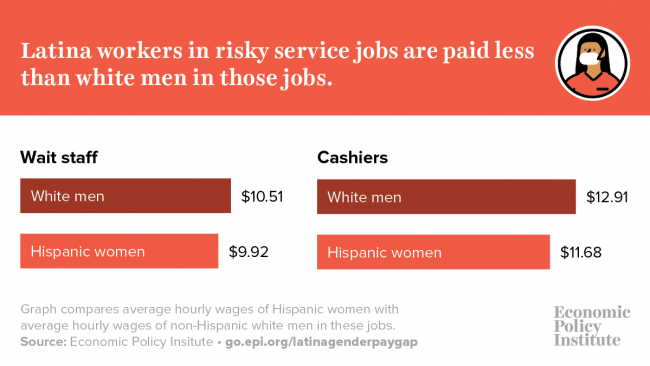Latina Equal Pay Day: Essential Latina workers face substantial pay gap during COVID-19 pandemic
October 29 is Latina Equal Pay Day, marking how far into 2020—nearly 11 months—the typical Latina must work to make the same amount as the typical non-Hispanic white man was paid in 2019. Latina workers are paid just 67 cents on the dollar on an average hourly basis, relative to non-Hispanic white men with the same level of education, age, and geographic location.
Although this alarming and unacceptable pay gap persists even in better economic times, it is particularly outrageous during the current public health and economic crisis, when many Latinas are essential workers. The infographics below take a closer look at average hourly wages of Latinas and non-Hispanic white men employed in major occupations at the center of national efforts to address COVID-19. These occupations include front-line workers in health care and essential businesses like grocery stores, those who have borne the brunt of job losses in the restaurant industry, and teachers and child care workers who have been all but abandoned in the U.S. coronavirus response. We find that Latinas make 6% to 32% less than non-Hispanic white men in these occupations.

Across these occupations, the pay disparities are largest among physicians and surgeons: Latina doctors, many of whom are currently treating coronavirus patients, are paid 68% of the average hourly wage of non-Hispanic white male doctors (a difference of $20.46 per hour). Meanwhile, pay disparities are smallest in service jobs: Latina wait staff and cashiers are paid 94% and 90%, respectively, of what non-Hispanic white men in those occupations are paid. Lastly, Latina teachers and child care workers are paid 84% of what non-Hispanic white men are paid in their respective occupations.



As these figures show, Latina workers have been essential during the pandemic, but they remain greatly underpaid. This pay gap has inflicted enormous economic damage on millions of Latina workers nationwide and has predisposed Latinas to be among the most hurt by the COVID-19 pandemic and economic shock. Equal pay for Latina workers is long overdue.
Data in this blog post come from EPI analysis of Current Population Survey Outgoing Rotation Group microdata, 2014–2019.
Enjoyed this post?
Sign up for EPI's newsletter so you never miss our research and insights on ways to make the economy work better for everyone.